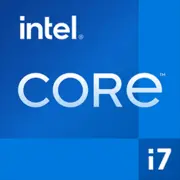Intel Core i7-11600H

인텔 코어 i7-11600H: 2025년의 성능과 이동성 균형
다재다능한 노트북을 찾는 사람들을 위한 프로세서 분석
아키텍처와 공정: 10nm SuperFin과 새로운 지평선
인텔 코어 i7-11600H 프로세서는 타이거 레이크(Tiger Lake) 라인업의 일환으로 출시되었으며, 모바일 CPU의 진화에서 중요한 이정표가 되었습니다. 10nm SuperFin 공정으로 제작된 윌로우 코브(Willow Cove) 아키텍처는 높은 트랜지스터 밀도와 에너지 효율성을 제공합니다. 이로 인해 기본 클럭 2.8GHz, 터보 모드에서는 최대 4.6GHz로 작동하는 6코어 및 12스레드를 탑재할 수 있었습니다. 주요 특징은 다음과 같습니다:
- L3 캐시 18MB — 자주 사용하는 데이터에 대한 빠른 접근을 지원합니다.
- 11세대 인텔 UHD 통합 그래픽 — 32개의 실행 유닛(EU), 4K@60Hz 및 HDMI 2.0 지원.
- PCIe 4.0 지원 — SSD 및 외부 장치에 대한 빠른 데이터 전송.
윌로우 코브 아키텍처는 분기 예측과 보안(예: 제어 흐름 강제 기술)도 개선했습니다. 통합 GPU는 독립형 그래픽 카드에 비해 성능이 떨어지지만, 가벼운 게임과 1080p 해상도에서 비디오 렌더링을 처리할 수 있습니다.
전력 소비 및 TDP: 35W — 한계일까?
프로세서의 명목 TDP는 35W이지만, 실제로는 터보 모드에서 45-50W에 이를 수 있습니다. 이는 특히 얇은 노트북에서 냉각 시스템에 부담을 줍니다. 그러나 인텔은 다음과 같은 기술로 이를 보완합니다:
- 인텔 다이나믹 튜닝 2.0 — 부하에 따라 전력을 적응적으로 조절합니다.
- 터보 부스트 맥스 3.0 — 가장 강력한 코어를 자동으로 오버클럭합니다.
사용자에게는 사무 작업 중 CPU가 경제 모드로 작동하고, 렌더링이나 게임 중에는 냉각이 효율적일 경우 잠재력을 발휘한다는 의미입니다.
성능: Excel부터 Cyberpunk 2077까지
사무 작업 및 멀티미디어:
- 브라우저에서 20개 이상의 탭을 열고 스트리밍 비디오를 재생해도 지연 없이 작동합니다.
- Premiere Pro에서 4K 비디오 렌더링: i7-10750H(코멧 레이크)에 비해 15-20% 빠릅니다.
게임:
- 통합 그래픽으로 실행하는 게임(CS:GO, Dota 2 등)에서 중간 설정으로 안정적인 60-80 FPS를 유지합니다.
- 독립형 그래픽 카드(NVIDIA RTX 3050)와 함께 사용할 경우 AAA 프로젝트를 Full HD 고급 설정으로 편안하게 게임할 수 있습니다.
터보 모드:
부하가 걸리면 프로세서가 잠시 4.6GHz까지 클럭을 유지하지만, 2-3분 후에는 컴팩트한 케이스에서 스로틀링이 발생할 수 있습니다. 양질의 냉각 시스템을 갖춘 게이밍 노트북(예: MSI 카타나 GF66)에서는 성능 저하가 최소화됩니다.
사용 시나리오: i7-11600H는 누구에게 적합한가?
- 학생 및 사무직 근무자: 멀티태스크, 문서 작업, 화상 회의.
- 창의적 전문가: 비디오 편집, 3D 모델링(독립 GPU와 함께).
- 게임 애호가: 중간 설정의 게임이나 외부 그래픽 카드를 사용할 경우.
이 프로세서는 8K에서의 무거운 렌더링이나 240Hz 스트리밍에는 적합하지 않으며, 이 경우 8개 이상의 코어를 가진 모델(예: AMD 라이젠 9 6900HX)을 선택하는 것이 좋습니다.
배터리 수명: 얼마나 버틸 수 있을까?
TDP 35W에서 이 CPU를 탑재한 노트북은 일반적으로 50-70Wh의 배터리를 장착합니다. 결과는 다음과 같습니다:
- 사무 모드(밝기 50%, Wi-Fi): 6-8시간.
- 비디오 시청: 최대 5시간.
- 게임: 1.5-2시간.
전력 절약 기술:
- 인텔 스피드 쉬프트 — 모드 간 즉각적인 전환.
- 윈도우 11 최적화 — 프로세스의 백그라운드 일시 중지.
추천: 60Wh 이상의 배터리 용량 및 빠른 충전 기능이 있는 모델을 선택하세요.
경쟁사와 비교: AMD, 애플 및 이전 세대
- AMD 라이젠 5 5600H (젠 3): 가격이 $50-100 저렴하지만, 단일 스레드 작업에서는 성능이 떨어집니다(Geekbench 6 단일 코어 ~1600). 멀티 스레드 작업에 더 적합합니다.
- 애플 M1: 에너지 효율이 뛰어나며(최대 18시간 배터리 수명), 하지만 윈도우 소프트웨어와의 호환성이 제한적입니다.
- 인텔 코어 i7-11800H (타이거 레이크): 10-15% 더 강력하지만 TDP가 45W로 발열이 더 큽니다.
2025년에도 i7-11600H는 게임 및 비즈니스 노트북의 예산형 부문에서 여전히 유효합니다.
장단점: 구매할 가치가 있을까?
강점:
- 높은 단일 스레드 성능.
- 썬더볼트 4 및 PCIe 4.0 지원.
- 작업과 게임 간의 균형 잡힌 성능.
약점:
- 얇은 케이스에서 발열 문제.
- 통합 그래픽 성능이 AMD 라데온 베가보다 떨어짐.
노트북 선택 시 권장 사항
1. 장치 유형:
- 울트라북 (예: ASUS 젠북 14): 휴대성에 중점을 두지만 스로틀링이 발생할 수 있습니다.
- 게이밍 노트북 (에이서 니트로 5): 최적의 냉각 성능을 제공하지만, 무게는 2.2kg 이상입니다.
- 워크스테이션 (레노버 생각패드 P15): 최대의 신뢰성과 업그레이드 가능성.
2. 주목할 사항:
- 냉각 시스템(최소 2개의 팬 + 구리 튜브).
- RAM: 16GB DDR4-3200.
- SSD: NVMe PCIe 4.0 (속도 3GB/s 이상).
3. 2025년 가격:
- 기본 모델: $800-1000.
- 프리미엄 모델: $1100-1400.
결론
2025년 인텔 코어 i7-11600H는 상대적으로 저렴한 가격에 범용성을 찾는 사용자에게 적합한 선택입니다. 이 프로세서는 다음과 같은 사용자에게 적합합니다:
- 작업용과 적당한 게임을 필요로 하는 사용자.
- 휴대성을 중시하지만 성능을 희생하지 않으려는 사용자.
주요 이점: 최신 인터페이스 지원, 가격 대비 성능 균형, 윈도우 생태계와의 호환성. 예산이 $1000-1200로 제한되어 있다면, 이 프로세서는 합리적인 타협이 될 것입니다.
기초적인
CPU 사양
메모리 사양
GPU 사양
여러 가지 잡다한
벤치마크
다른 CPU와 비교
소셜 미디어에서 공유하기
또는 링크로 소개하기
<a href="https://cputronic.com/ko/cpu/intel-core-i7-11600h" target="_blank">Intel Core i7-11600H</a>